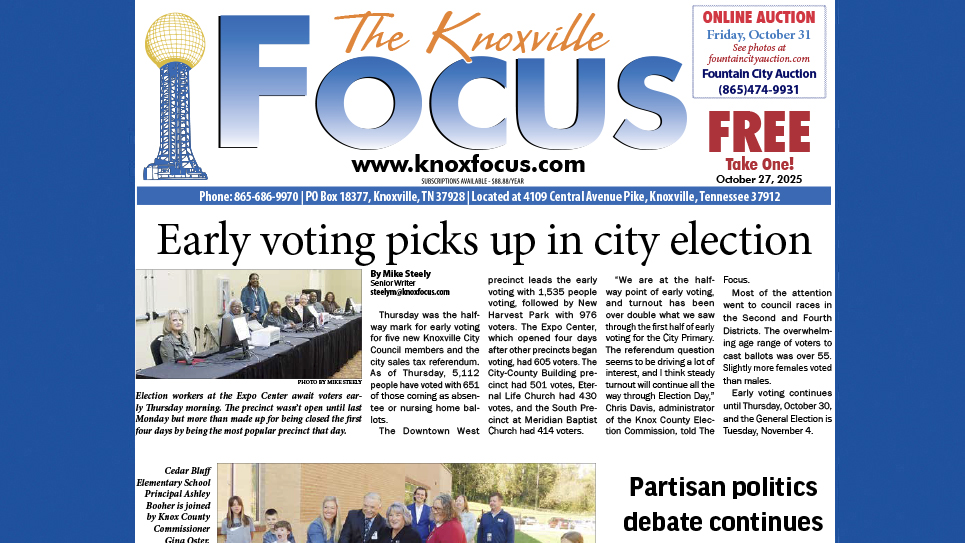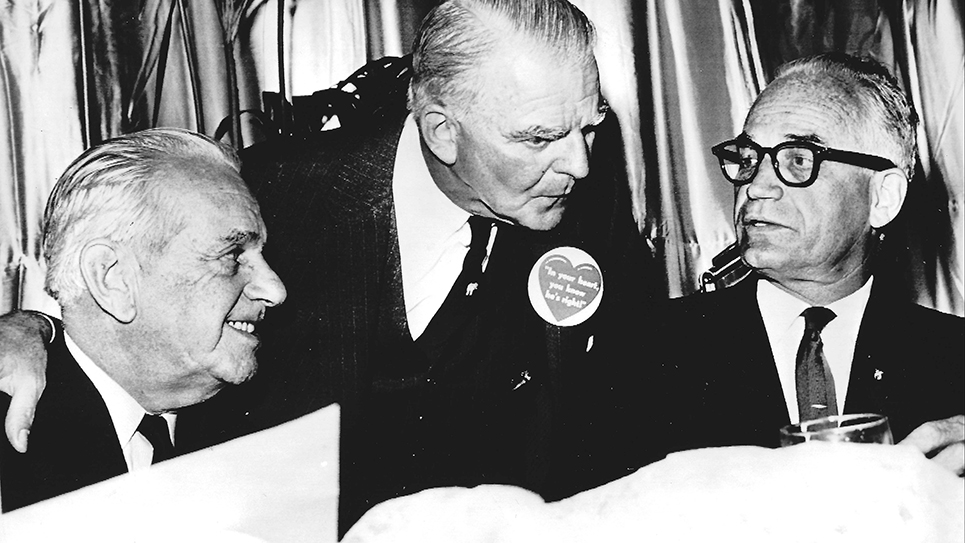By Ray Hill
Outside of Arizona, few people remember Ernest McFarland save for the man Barry Goldwater beat to get to the United States Senate. Yet Ernest McFarland was much more than a rudimentary politician. McFarland rose from county judge to United States senator, governor, and Chief Justice of the Arizona Supreme Court. While in the United States Senate, Ernest McFarland was the Majority Leader. A modest man, McFarland achieved considerable success as a businessman, owning one of the Grand Canyon State’s first television stations during the Golden Era of that medium. In fact,
Tom Chauncey, a veteran Arizona broadcast owner believed McFarland “had more to do with freedom for television-station owners to operate than any single individual in Congress or the Senate.” “He was never given the credit due him for writing federal legislation that kept television straight,” Chauncey insisted. Tom Chauncey, the owner of a couple of radio stations had owned what became KTSP and admired Ernest McFarland’s efforts to write legislation which prevented the federal government from controlling television programming.
McFarland was also a fine lawyer and one reporter who covered the governor for years recalled, “Few Arizona lawyers could match his knowledge of water and land laws.” One Arizonan remembered McFarland “dressed like a banker, looked like a judge and talked like a rancher.” When he died, one reporter wrote Ernest McFarland was “a convincing orator with a sharp mind.” Known to most everyone as “Mac”, Ernest McFarland was personally popular with his people for decades. Arizonans bestowed upon “Mac” McFarland virtually every office within their gift to give.
Ernest William McFarland was literally born in a log cabin in Pottawatomie County, Oklahoma. The McFarland family moved to Okemah, which had the effect of delaying McFarland’s education for a year as the town had no schools. While in Ada, Oklahoma, McFarland joined a debate club, one of the members was a young man named Robert S. Kerr, who would later serve as governor of the Sooner State and the two men would serve together in the U. S. Senate. When the United States entered the First World War, Ernest McFarland enlisted in the U. S. Navy. McFarland was sidelined by pneumonia and was later plagued by a variety of illnesses. After being honorably discharged, Ernest McFarland returned home to Oklahoma, but decided to move to Arizona. McFarland worked at a local bank before going to Stanford Law School.
Ernest McFarland methodically moved up through the political ranks of his adopted state, serving as an assistant state attorney general and winning election as Pinal County attorney. In 1934, McFarland was elected Pinal County Superior Court Judge, a post he held until 1940 when he challenged incumbent U. S. senator Henry Fountain Ashurst. Senator Ashurst was something of a majestic figure, elegant and astonishingly eloquent, who had served in the United States Senate since Arizona became a state, February 14, 1912. Ashurst barely campaigned for reelection, depressed over the death of his wife. Senator Ashurst only won over a third of the vote and Ernest McFarland took better than 56% of the ballots cast. At the time, Arizona was a profoundly Democratic state; only one Republican had managed to win a Senate seat and that had been in 1920, which had been a banner year for the GOP. Ralph Cameron had served only a single term, but made repeated attempts to return to the U. S. Senate.
McFarland won almost 70% of the vote in 1946 to win reelection to the United States Senate. In 1950, Scott W. Lucas of Illinois was Majority leader of the United States Senate. Lucas was upset in the 1950 election by former congressman Everett Dirksen and Ernest McFarland became the new Majority Leader. The Majority Whip was a young senator from Texas, Lyndon Johnson. Like Lucas, the burden of carrying the Truman administration program inside the Senate proved to be a difficult task, but worse still, it was costly politically. There were signs Republicans were making gains in Arizona; Howard Pyle had been elected governor in 1950 and was running for a second term in 1952. Yet McFarland did not believe his opponent, a young city councilman from Phoenix, Barry Goldwater, represented any real threat to his continued tenure in the U. S. Senate. With former general Dwight D. Eisenhower leading the GOP ticket, along with Governor Howard Pyle, Goldwater campaigned hard and waged an effective bid for the Senate. McFarland was stunned when Goldwater edged him out by 6,725 votes. Few people who knew “Mac” McFarland believed he was done with politics.
McFarland augmented his law practice by working part-time as a lobbyist for interests that reflected his own businesses. The former Majority Leader represented RCA Communications, the American Cable & Radio Corporation, and Western Union Telegraph Company. McFarland was also busy navigating the Washington bureaucracy to obtain a television permit for himself and other investors. The Tucson Arizona Daily Star reported on February 15, 1954 the former senator was “seriously” pondering the gubernatorial race that year. According to the Daily Star, McFarland had “already made overtures to certain key Democrats to form ‘McFarland for Governor clubs” in several Arizona counties. Joe Haldiman, a Phoenix insurance man who had run against Governor Pyle in 1952 and lost badly, apparently very much wanted another crack at the gubernatorial race, but realized he couldn’t defeat Ernest McFarland in a Democratic primary contest. The worst kept secret in Arizona during 1954 was Ernest McFarland’s gubernatorial ambitions. On June 3, 1954, the former senator made it official; he was running for governor. McFarland easily swept aside his opponents in the primary and focused his fire on incumbent Howard Pyle.
Howard Pyle had been reelected governor winning better than 60% of the vote, yet his personal popularity suffered when he tried to dissolve a polygamous, quiet fundamentalist, Mormon enclave in Colorado City, Arizona, which became known as the Short Creek Raid. More than 200 children were taken away after two dozen men had been arrested. Unfortunately for Governor Pyle, the newspaper photographs of crying children being led away from their mothers horrified a goodly number of Arizonans and harmed his own political popularity.
McFarland hammered home the importance of the chief executive being able to get things done, a problem for Howard Pyle as the state legislature was overwhelmingly Democratic. Ernest McFarland may well have been the only Democrat who could have successfully dislodge Howard Pyle from the governor’s chair. Pyle was reputedly already eyeing the Senate seat of eighty year-old Carl Hayden, which would come up in 1956. McFarland won the governor’s race with 52.5% of the vote. The defeat ended Howard Pyle’s political career.
“Mac” McFarland ran for a second term as governor in 1956 and carried every county in the state in his reelection bid, defeating Republican Horace B. Griffen easily. It soon became clear Governor McFarland was considering a return to Washington, D. C. and avenging his earlier loss to Barry Goldwater in 1952. McFarland was likely the strongest candidate Democrats in Arizona could field against the conservative firebrand in 1958. The rematch of Barry Goldwater and Ernest McFarland produced the kind of sparks everybody imagined. The race was bitter and hard fought. America was in the middle of a recession and 1958 would prove to be a disastrous year for Republican candidates. Republicans lost thirteen seats in the U. S. Senate that year but one of them was not the seat occupied by Barry Goldwater. Governor McFarland carried four of Arizona’s fifteen counties against Senator Goldwater. Goldwater increased his majority, beating McFarland by more than 35,000 votes and winning 56% of the ballots cast. The forty-nine year-old Barry Goldwater exulted he would continue to fight “those forces who want to concentrate excessive power in government, unions or business.” Goldwater’s showing helped Republican Paul Fannin to upset Attorney General Robert Morrison in Arizona’s gubernatorial race. Barry Goldwater’s sound defeat of Ernest McFarland was also considered an upset as the governor had gone into the senatorial election as the presumed favorite up until the last few hours of the race. McFarland, who knew where the votes were, conceded Goldwater’s victory before half the votes were counted.
The Flagstaff Arizona Daily Sun summed up the defeat of the Democratic ticket in the Grand Canyon State in an editorial. “With a preponderantly heavy Democratic registration, with surveys and pre-election polls favoring Gov. Ernest McFarland and Robert Morrison, the Arizona Democrats forgot about issues and contented themselves with presenting these two party wheel-horses on a ballyhoo campaign background that was in style around the turn of the century,” the editorial thundered.
The second loss to Barry Goldwater was a bitter defeat for Ernest McFarland. Senator Goldwater was popular with the people of Arizona and he effectively campaigned as a foe of union corruption and highlighted the governor’s support from labor unions. McFarland resumed the practice of law after leaving the governor’s office until he announced as a candidate for the Arizona State Supreme Court in 1964 when he was almost seventy years old. Incumbent Renz Jennings declared his candidacy for the U. S. Senate to succeed Barry Goldwater, who was running for the GOP presidential nomination. McFarland ran to replace Jennings on Arizona’s high court. The former governor had tried to succeed Renz Jennings once before, in 1962 when the justice said he was running for Congress. Jennings later withdrew as a candidate due to his wife being ill. Some had thought McFarland might run for governor once again, but the old warhorse preferred to end his political career on the Arizona State Supreme Court. When asked if he had consulted the leaders of his party about his announcement, the former governor replied, “Frankly, I haven’t talked to anyone about it.”
While nominations to the Arizona Supreme Court were made by parties, the general election was nonpartisan. Among the newspapers endorsing McFarland’s candidacy was the Daily Star which published an editorial urging the former governor’s election. The Daily Star said the high court was not the place for “a politician on the rise” but rather “a place for the highest, calmest, most judicial talent the State of Arizona can find.” The Daily Star said it believed Ernest McFarland “fits this description.” McFarland was one of the two top vote getters and won a place on Arizona’s State Supreme Court. At the conclusion of his term in 1970, Ernest McFarland opted to retire.
After leaving the State Supreme Court, McFarland and his family bought majority ownership in the Arizona Television Co., Inc. and KTVK for $6 million. McFarland was also honored for his long service to the people of Arizona with a testimonial dinner in 1971, attended by 1,000 people. Former presidents Harry Truman and Lyndon Johnson sent greetings to the former senator, as did President Richard Nixon.
As he and his wife aged and became increasingly infirm, McFarland and his wife turned over their ownership interests to their daughter and son-in-law who was the president of the family business. McFarland’s law office was housed inside the KTVK building and the former senator and governor remained active in Arizona politics, attending the 1972 Democratic National Convention which nominated South Dakota senator George McGovern to face incumbent Richard Nixon in the presidential election. Ernest McFarland remained a fixture at state Democratic Party functions in the Grand Canyon State.
In his later years, like most of us, Ernest McFarland faced several health challenges. McFarland had a benign brain tumor removed in 1977 and a “saucer-sized portion of his skull was removed and replaced by a plastic plate.” Some two hundred people gathered in Florence, Arizona to honor the “physically feeble” former governor in 1980. McFarland published his autobiography, Mac, and singed copies of his book at the State Capitol in Phoenix where he occupied his old office, which had been restored. One of the former governor’s last public appearances occurred on February 11, 1982 when, alongside two other former governors, Howard Pyle and Jack Williams, Ernest McFarland arrived in a wheelchair to salute a state legislator. McFarland died at age eighty-nine on June 8, 1984.






